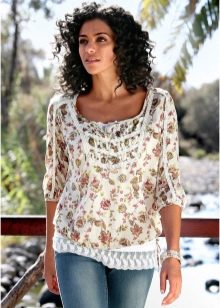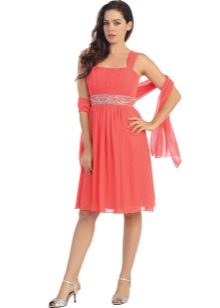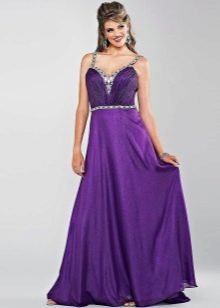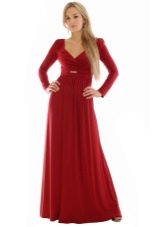Empire style in clothes

It's no secret that fashion moves in a spiral, and sooner or later, various trends reappear in the images of modern women. Empire style is no exception.



Moreover, his main characteristics are so successful that they have allowed him to stay in the fashion world for a long period of time.

Style history
The classic Empire style lasted only a quarter of a century. However, he was so fond of beauties that modern women of fashion transformed him for themselves.
After the Great French Revolution at the end of the 18th century, the distinction between different social strata was smoothed out. The society became democratic and progressive, which marked the beginning of a new, more modern era. Such dramatic changes could not but be reflected in the manner of dress. High wigs, lush crinolines, fancy accessories were sent to the furnace. They were replaced by simplicity, tenderness, sophistication and sophistication of taste.

At the same time, the great Napoleon I Bonaparte ascended the French imperial throne, and with him the beautiful Josephine Beauharnais appeared on the historical arena. It was she who became the inspiration for the new style. Every European fashionista dreamed of being like the beloved of the great commander.

Characteristics
The dress "schmiz", which in French means "shirt", became the hallmark of the Empire style. Indeed, previously, such a cut of dresses was only applicable for shirts that were worn under fluffy outfits. In appearance, the dresses of fashionistas of the early twentieth century resembled light Greek clothes, chitons. It is not surprising, because the trendsetter of the Empire style, the charming Josephine, was a great admirer of the Hellenic culture.
The silhouette of the schmiz dress was supposed to resemble an antique column. The cut of such an outfit provided for a short bodice with a deep cut, which went literally along the chest line. The sleeves were short in the form of "lanterns" on wide cuffs. The main part of the decoration fell under the bodice in flowing lines. In front it seemed straight, and on the back it was tucked together so that small folds gave the image even greater lightness.

The outfits were made of airy transparent fabrics, and thick silk was used as a lining. In the heyday of the Empire, women preferred white and pastel colors more. Later, the colors could be absolutely any. But the dresses remained monochromatic.

Decorative items and accessories
A variety of decorative solutions gave refined luxury to plain dresses with simple cut. To give the product a more elegant look, it was enough to sew a thin train at the back.
Empire style dresses are characterized by the accentuation of the high waistline with satin ribbons or edging, which is more complex in its design. The decoration for evening events and celebrations had an ornate bodice. The decor was embroidery with gold or silver threads. For women of the early nineteenth century, there was no craving for colorful outfits. Therefore, women of fashion preferred to use decorative elements to match the outfit.



In cold weather, young ladies wrapped themselves in a cashmere shawl; it also played a big role in shaping the image. As for other warm things, the poor girls were not lucky here. Women's fashion then did not involve wearing outerwear. Ladies in fine silks looked even more absurd in a fierce winter against the background of men, who, on the contrary, at that time welcomed multi-layered clothing. Despite the constant colds, women continued to stubbornly follow fashion trends, dressing warmly, except for riding.



White husky gloves emphasized thin hands and graceful movements. The young lady's head was decorated with all kinds of hats, berets, caps and even turbans. These items of clothing played the role of accessories.

Empire fashion dictated the rules not only for clothing, but also for appearance. Maximum naturalness of the image was welcomed. The use of cosmetics has been minimized. Fashionistas' skin should be aristocratic pale. Therefore, another indispensable accessory for ladies is a lace or silk umbrella.



Style advantages
The cut of Empire-style dresses is so versatile that it suits any shape. The proportions of the schmiz are shifted to 1: 6, hugging only the chest, and the rest of the figure is covered with a flowing cascading fabric.



For skinny girls, a short, tight bodice will lift the chest, and a loose skirt will give the figure a feminine silhouette. For owners of curvaceous forms, such an outfit is also ideal. A high waist will emphasize the advantages and visually smooth out any flaws.

That is why the cut of dresses in the Empire style is relevant to this day. There is no more successful style that would suit women of different constitutions and ages. Under such a maxi dress, you can wear both high-heeled and flat-soled shoes.



Empire elements in modern outfits
The present time is characterized by a combination of various styles with the use of certain techniques taken from the past. Echoes of the Empire style have persisted to this day, although in the classical form it is found only among individual customers.

Modern outfits can be extremely short, such as baby doll dresses. And the decoration is much more modest than that of the products of the early 19th century. But the main feature - high waist - remains unchanged.



Evening dresses
Empire style is reflected in many wedding and evening dresses. As for celebrities, it will be easy to find an image with elements of ancient style on the red carpets.



The upper part of modern models can combine an empire-style bodice with long sleeves or wide straps. The depth of the neckline ranges from revealing to high. Evening dresses adhere to the classic canons. The skirt retains its maximum length or has a small train.




Casual wear
In the collection of any couturier there are models of sundresses and blouses with a high waist, emphasized by decorative details.



Any casual outfit to a greater or lesser extent admits the presence of fashionable elements of the early 19th century. Thanks to its flowing silhouette, the cut is a favorite for expectant mothers.



As strange as it may sound, the characteristic features of the Empire style can be perfectly combined with a business style. A laconic dress with a modest finish will be appropriate in the office, even with the strictest dress code. If at work it is permissible to wear more interesting outfits, then the dress can be decorated with contrasting trim. Modern models now allow for bright prints on Empire style products.

The model of maxi-sundresses is widespread, in which instead of the classic tight-fitting bodice there is a "collar".



Due to the variety of colors, this dress model can be chosen for any occasion. A bright rainbow sundress is perfect for walks and dates, and a monochromatic model is perfect for evening events.









